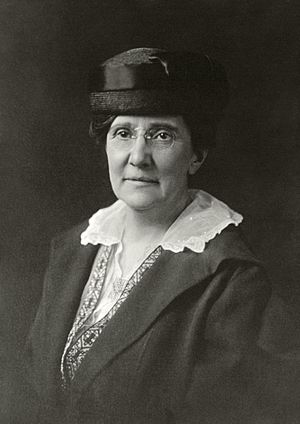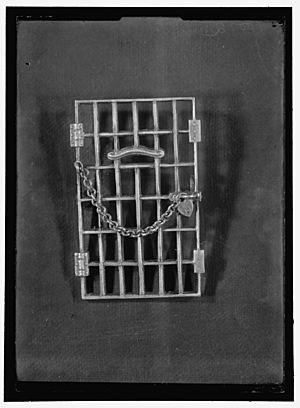Caroline Spencer (suffragist) facts for kids
Quick facts for kids
Caroline Spencer
|
|
|---|---|
 |
|
| Born | October 30, 1861 Philadelphia, Pennsylvania, U.S.
|
| Died | September 16, 1928 (aged 66) Pennsylvania, U.S.
|
| Nationality | American |
| Occupation | Physician, activist |
Caroline Spencer (born October 30, 1861 – died September 16, 1928) was an American doctor. She was also a strong supporter of women's rights. She worked hard to get women the right to vote. She campaigned in her home state of Colorado and across the country.
Caroline was one of the many Silent Sentinels. This group protested peacefully outside the White House. She also took part in "Watchfires." These events happened in the final months before the 19th Amendment was passed. This amendment gave women the right to vote. In 2006, she was honored in the Colorado Women's Hall of Fame.
Contents
Early Life and Education
Caroline E. Spencer was born in 1861 in Philadelphia. Her father, J. Austin Spencer, was a lawyer. Her mother, Anna Brock Spencer, died when Caroline was nine years old.
Caroline went to the Philadelphia Normal School For Girls. She earned a special medal for her great schoolwork. After graduating in 1880, she taught history there for a while. Later, she studied at the Women's Medical College, Philadelphia. She earned her medical degree in 1892. She worked as a doctor for the rest of her life.
Caroline had long-term health issues like bronchitis and asthma. In 1889, she visited Colorado. She hoped the climate would help her feel better. Four years later, after becoming a doctor, she moved to Colorado Springs.
Fighting for Women's Rights
In Colorado, Caroline became very active in the Woman's Suffrage Movement. This movement worked to get women the right to vote. She helped start the Women's Club of Colorado Springs in 1902. She also founded the Civic League in 1909. The Civic League supported both women's rights and workers' rights. It eventually had to close in 1914.
Women in Colorado had already won the right to vote in their state in 1893. So, Caroline and her friends focused on a national law. They wanted the 19th Amendment to pass. In 1913, Caroline joined Alice Paul's group. It was first called the Congressional Union. Later, it became the National Woman's Party.
Colorado Springs became the main office for this group in Colorado. Caroline was known as a strong leader. She helped organize many events to raise awareness for women's suffrage. Colorado Springs became a stop for "Suffrage Specials." These were cross-country car and train tours.
I accept my sentence under protest because of my innocence of any unlawful act, for the purpose of showing the nation that the women voters are equal to any sacrifice necessary to secure political freedom.
Caroline also took part in many public protests. These happened in Colorado and Washington D.C. In 1916, she protested speeches by William Jennings Bryan and President Woodrow Wilson. On December 5, 1916, she sat in the front row of a balcony. She was with four other women. This was during the President's yearly speech to Congress.
As President Wilson began to speak, they unrolled a banner. It hung over the balcony. The banner asked, "Mr. President, What Will You Do For Woman Suffrage?" Wilson did not react to the banner. A Senate page quickly took it down. However, the women became famous across the country. Journalists reported on their brave act.
The Silent Sentinels
Between 1917 and 1919, Caroline was one of many women called the Silent Sentinels. They stood quietly in front of the White House. They held signs and banners for their cause. Protesting was not illegal. But after the U.S. entered World War I in 1917, police warned Alice Paul. They said arrests would happen if the women continued. Caroline Spencer was arrested three times. She was also sent to jail twice.
On October 6, 1917, eleven women, including Caroline, marched. They walked from the Capital Building to the White House. They carried banners as they walked. A group of men attacked them and pulled down their banners. Police watched but did not stop the men. The eleven women were arrested. They were charged with blocking traffic. Two days later, a judge let them go.
On October 20, 1917, Caroline was arrested again. This happened while she was protesting at the White House. Alice Paul, Gladys Grenier, and Gertrude Crocker were also arrested. After their trial, Paul and Spencer were given 7-month jail sentences. Grenier and Crocker could pay a $5 fine or go to jail for 30 days. They refused to pay the fine and were jailed.
While in jail, Caroline was in a dusty cell with no fresh air. She had a severe asthma attack. A doctor ordered her release. Later, she received a silver brooch. It was shaped like a prison door. Alice Paul had it made for the 90 women who went to jail for women's rights.
After her release, Caroline went back to Colorado to recover. In late 1918, she wrote to Alice Paul. She wanted to return to Washington when the vote on the amendment was near. In December, the suffragists held a ceremony. This was while the president was traveling in Europe. They burned copies of Wilson's speeches in front of the White House. Caroline was there. She repeated Wilson's words before burning his speech. She said, "in memory of the great Lafayette -- from a fellow servant of liberty."
Later that month, the National Women's Party decided to continue "Watchfires." These fires would burn until the Susan B. Anthony Amendment passed. On January 1, 1919, a large pot was set up in front of the White House. It held the fire. Women were asked to bring wood from their home states to keep it burning. Police often put out the fires and made arrests. On January 18, Caroline relit the fire. She used wood she brought from Colorado. Then she started burning copies of Wilson's latest speeches. She was arrested with twenty-two other women and sent to jail.
Finally, on June 4, 1919, the amendment passed! Now, three-quarters of the states needed to approve it.
Later Life
After the amendment passed, Caroline returned to Colorado. She worked with the Woman's Party there. On December 12, 1920, the Colorado state government approved the 19th Amendment.
Caroline continued to fight for women's rights after 1920. In 1922, she helped create a branch of the National Women's Party in Philadelphia. Two years later, she helped organize a rally. Its goal was to get women elected to Congress from Pennsylvania.
Caroline was diagnosed with tuberculosis. She left Colorado and moved back to Pennsylvania to live with her sister. She died there on September 16, 1928.
In 2006, Caroline Spencer was honored by Colorado. She was added to the Colorado Women's Hall of Fame.
Images for kids



